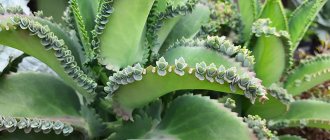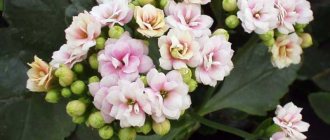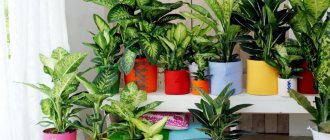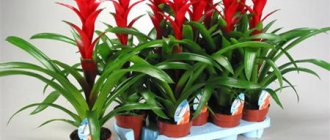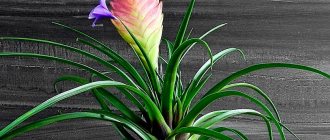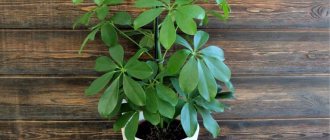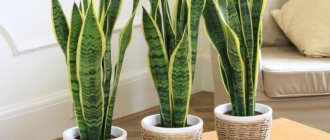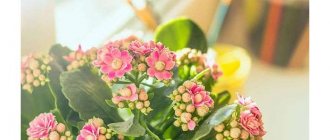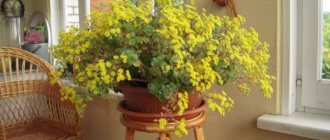Kalanchoe is one of the tropical exotic flowers that came to us from South America and Africa. It has long earned its popularity due to its beautiful flowering and medicinal abilities. In nature, Kalanchoe is represented by many varieties and varieties that belong to the group of succulents. In our article we will tell you about the most popular varieties, and also give some tips on growing them in your apartment.
Kalanchoe Kalandiva
This type of plant belongs to the Crassulaceae. It is considered very low maintenance. It only needs sufficient lighting, regular watering and a location away from drafts and direct sun exposure. The intensity of Kalanchoe flowering depends on the duration of the lighting period. Flowers of this species are beautiful inflorescences on medium-length peduncles. Flowers can be red, yellow, orange, pink, purple and others, depending on the variety. Flowering continues for several months. Kalanchoe itself is a small shrub with a thick trunk covered with beautiful fleshy leaves. The surface of the sheet can be glossy or velvety. This plant grows up to 30 cm in height.
Since this type of Kalanchoe was produced by man by crossing several varieties, you will not see it in nature. The basis for breeding this variety was Kalanchoe Blos Ferida, which combines several varieties that differ in flower color. Flowers of this species can be red, purple, white, pink, bright orange, and also have a two-color color. All of them consist of four petals, but in 2002 a variety appeared with 32 petals, the appearance of which was similar to a small rose. The general appearance of the bush resembles a beautiful blooming velvet ball. The leaves are opposite, held on short petioles, have a dark green color and a rounded shape. Flowering begins in December and continues until mid-summer. Due to the fact that this species was bred artificially, it is very rarely susceptible to various diseases and the problems that arise during its cultivation are the result of improper care of Kalandiva.
Why Kalanchoe does not bloom - reasons
Good growth and flowering of Kalanchoe depends on proper care for it. If you have complied with all the conditions described above, then your flower is in no danger.
Otherwise, you have made a number of mistakes. The main ones are:
- Unsuitable soil.
- Insufficient lighting.
- Short daylight hours.
- Too much or, conversely, insufficient watering.
- Temperature violation.
In addition, they can affect the flowering of diseases. And of course – the formation of a bush. This factor is essential for the flowering of the plant. Formation is carried out by pruning and pinching the bush. This was discussed above.
Kalanchoe Degremona
One of the most popular indoor flowers that can be seen in many homes. Also known as Bryophyllum Degremona. This type of Kalanchoe was brought to us from Madagascar. It is a succulent plant with a strong, straight stem that becomes woody at the base over time. The leaves are located on the stem opposite each other, which are attached to the petioles, have a fleshy structure, dark green color and an elongated triangular shape. The back of the leaf plate is painted with pink-violet stains. Kalanchoe of this species belongs to the “viviparous” plants. It grows small full-fledged plants - “babies”, which are attached to the edge of the leaf, have 2-3 true leaves and an independent root system. Over time, the babies detach from the mother leaf, fall into the ground and take root. In this way you can quickly propagate Kalanchoe.
Kalanchoe Degremona is distinguished by large bell-shaped flowers of purple-pink color. Flowering begins in autumn and continues throughout winter, making this flower very popular among gardeners. When growing this plant, you should be careful about the watering regime, since if it is over-watered, the flower may get sick and die. Also, Kalanchoe does not like drafts and direct sun, the rays of which cause burns on its leaves and flowers.
Recommendations from experienced plant growers
Some tips for growing Kalanchoe from experienced gardeners:
- You should not put Kalanchoe in a plastic container. Moreover, metal-plastic windows can also negatively affect crop growth. It is not always possible to place the tree of life away from plastic windows. But if this succeeds, the Kalanchoe will thank the grower with abundant flowering and rapid growth.
- The succulent blooms from February to March, but it can also be grown in greenhouses. Then flowering can be achieved at the very beginning of winter. The grower must provide the plant with bright lighting, regular feeding and proper watering.
- If it is not possible to maintain the room temperature above 10 C°, the Kalanchoe needs to be additionally illuminated and warmed with lamps.
Among the numerous varieties of Kalanchoe, there are both decorative and medicinal varieties. This culture is considered hardy and unpretentious in care, which is why plant growers like it so much. Kalanchoe is a plant with powerful energy, gives a person confidence in his abilities and keeps peace in the family.
Kalanchoe Pinnate
A distinctive feature of this species is that it is used in folk medicine as a medicine. Each type of Kalanchoe has some of its own healing properties, but Cirrus is endowed with them to the greatest extent. In addition, this plant has a very beautiful decorative appearance, allowing it not only to be beneficial as a medicine, but also to decorate your window. In the wild, you can see Kalanchoe pinnate in Southeast Asia or America. In the natural fauna, it can grow up to one and a half meters in height, but when grown indoors, it is a low shrub with an erect stem of a fleshy structure, which has a woody lower part. The leaves are large, elliptical in shape with wavy edges. The upper leaves are pinnately dissected, oval-shaped, dark green in color, and may have a red or yellow tint. This type of Kalanchoe is also “viviparous” and grows “babies” along the edges of the leaf. Flowering begins when the plant reaches two years. The flowers are large, pink-green in color, located on the tips of the shoots in paniculate inflorescences. Flowering occurs irregularly. After flowering, a leaflet is formed - this is a fruit that can be used to propagate this type of Kalanchoe. Growing such a plant at home is not particularly difficult. It is recommended to add complex mineral fertilizers to the soil and moisten the flower only after the earthen ball has formed. The plant does not like drafts and direct sunlight.
Properties of Kalanchoe - harm and benefit
Medicinal properties of Kalanchoe
Kalanchoe has anti-inflammatory, hemostatic, cleansing, wound-healing and bactericidal properties. Kalanchoe juice contains tannins, polysaccharides, flavonoids, organic acids, macro- and microelements. The use of Kalanchoe for medicinal purposes is determined not by the value of any one chemical compound, but by the unique combination of all substances that make up the plant. Kalanchoe juice is used to treat ulcers, boils, burns, dead tissue, purulent wounds, bleeding and cervical erosion. With the help of Kalanchoe you can get rid of acne, blemishes and rashes on the face, warts, vitamin deficiency and loss of strength. Plant preparations treat diseases of the eyes and eyelids, varicose veins, tuberculosis, mastitis, sinusitis, otitis media, psoriasis, periodontal disease and even common flu. When grown in a dark, cool room, Kalanchoe accumulates many biogenic stimulants that enhance its healing effect.
Medicinal Kalanchoe - contraindications
Kalanchoe and its preparations are contraindicated for pregnant women, allergy sufferers, hypertensive patients, people suffering from individual intolerance to Kalanchoe, cirrhosis, hepatitis and other liver diseases. Cancer patients are also not recommended to consume Kalanchoe. When treating diseases in children, the plant juice should not be used undiluted, as it can cause burns.
Kalanchoe Benta
This type of Kalanchoe differs from others in its ability to accumulate moisture inside the leaves. This way it builds up moisture reserves and the leaves have a fleshy, thick texture. This property allows the plant to be moistened extremely rarely, and the juice accumulated in the leaves has a wide range of healing properties. The appearance of the plant is a highly branched large shrub that grows up to one meter in height when grown indoors. The leaves on the trunk are large, have an elliptical shape and are arranged in 6 pairs. Kalanchoe Benta blooms with snow-white flowers, which are collected in umbrella inflorescences. The flowers have obovate petals. Flowering begins in mid-spring and lasts for a month. In order to prolong the flowering period, as well as to help the plant regain its strength after it, you should feed the Kalanchoe with complex mineral fertilizers.
Watering and lighting
Before watering, you should make sure that the top layer of soil has dried a few centimeters. In winter, reduce the number of waterings to once a month. For irrigation, use settled water at room temperature. During watering, water should not get on the leaves and inflorescences, otherwise the bush may rot.
In summer, it is recommended to keep the flower on windows on the south or east side. When the sun is very hot, the succulent must be shaded so that it does not get sunburn. In winter, the crop can be grown on a south-facing window.
Kalanchoe Blossfeld
This type of Kalanchoe is one of the most popular plants grown at home. He was loved for his low maintenance requirements and beautiful appearance. This bush grows up to 40 cm in height, has a very compact shape and a wide range of flower colors. In addition, its leaves have healing properties, which are used in folk medicine for healing wounds and as an anti-inflammatory agent. Begging for such a plant will not cause you much trouble. You just need to periodically fertilize, prune and moisten it. This species also stores moisture in its leaves and can tolerate periods of drought well. When grown in a location with indirect sunlight, Kalanchoe will provide you with flowers for a long period. In the nature of Madagascar, where this Kalanchoe comes from, it is found only with red or orange flowers. However, based on them, many varieties with multi-colored colors were bred. In order to get abundant flowering, experienced flower growers advise cutting off flower stalks immediately after the flowering period. This procedure stimulates the formation of buds for subsequent flowering. When the Kalanchoe has completely bloomed, it is trimmed to the first leaves and the watering periods are reduced. This will provoke the formation of new buds and rapid subsequent flowering.
Caring for Kalanchoe at home
Lighting
For Kalanchoe at home, the optimal daylight hours are 12 hours. Therefore, the best place for a pot of Kalanchoe from spring to autumn is windows on the east or west side. In winter, it is better to place the flower on a southern windowsill. If daylight hours in winter are very short, then it should be brought to the required level with the help of additional artificial lighting.
Temperature
The Kalanchoe flower feels good indoors at almost any temperature. Within reasonable limits, of course. These limits range from 18 to 28 °C in summer, and from 14 to 18 °C in winter. A decrease in temperature below 10 °C threatens disease and death of Kalanchoe. Low temperature (14-18 °C) promotes bud formation.
Watering Kalanchoe
Homemade Kalanchoe is watered with soft, warm, settled water. Water as the top layer of soil dries, under no circumstances allowing the earthen clod to dry out completely - this leads to a massive fall of Kalanchoe leaves. In winter, water 3-4 days after the substrate dries. Watering can be done through the tray.
- Hydrangea at home: care and propagation
Spraying
The indoor Kalanchoe plant does not need spraying, but in hot weather this will only have a positive effect on the development of the plant. If the plant is not sprayed, nothing bad will happen. The leaves of the indoor Kalanchoe flower are fleshy, sometimes pubescent, and moisture evaporates weakly.
Top dressing
Kalanchoe needs fertilizer only in the summer, as well as during the budding period in the fall. You can use the same fertilizers that are intended for feeding cacti. In summer, mineral fertilizers are used 4 times a month, and organic fertilizers – 2 times.
Trimming
Since many types of Kalanchoe shed old leaves, these shoots can be trimmed and planted separately or in the same pot. In other species, the shoots overflow the edge of the pot - they can also be trimmed and planted nearby, or they can be left hanging.
Bloom
For good flowering, daylight hours in the spring-autumn period should be no more than 10-12 hours, but the lighting at this time should be very bright. Flowers of some varieties can be cut and placed in a vase, where they can last for several weeks. When indoor Kalanchoe has faded, some of the stems are cut off, giving the plant a beautiful appearance. Do not throw away the cut shoots, but use them for cuttings.
Replanting Kalanchoe
Kalanchoe is replanted only if the plant has grown greatly. Expanded clay or small bricks are poured into the bottom of the pot, which will allow excess water to drain away. Young specimens are planted in a substrate consisting of turf soil, deciduous soil, sand and peat (4: 2: 1: 1). You can use store-bought substrate for succulent plants. For epiphytic Kalanchoe, it would be a good idea to add a little humus to the soil mixture.
Propagation by cuttings
You can root either a piece of the stem or a leaf. All you need to do is separate the leaf from the mother plant in early summer and plant it in nutritious soil. The leaf should be covered with a jar and sprayed from time to time. Soon the leaf will sprout roots.
- Kerria: growing in the garden, types and varieties
Growing from seeds
Kalanchoe reproduces well by seeds. Sowing of seeds is carried out at the end of winter - beginning of spring in deciduous soil. Sow on the surface, then press down with your finger, without sprinkling soil on top. The container with seeds is covered with glass and paper, ventilated in the morning and evening, and the temperature is not allowed to drop below 16 °C or rise above 20 °C. The earth is regularly watered with warm water, not allowing it to dry out completely. When the first shoots appear, the glass and paper are removed. After 3-4 weeks, the sprouts dive into a larger container. The next transplant is done when the Kalanchoe has 3-4 leaves. Drainage is poured onto the bottom of the pot, and a mixture of peat, turf soil and sand (4:2:1) is placed on top. When the indoor Kalanchoe flower takes root, the top needs to be pinched for better branching. The Kalanchoe is replanted the next time the roots fill the pot. The soil is made up of compost, humus, leafy soil and sand (4:2:1:1). The first flowering can be observed next year.
Kalanchoe Bukhara
This species is a medium-sized subshrub native to Madagascar and Southeast Asia. This species is distinguished by a thin, weakly branched trunk, which is not covered with leaves in the lower part. When grown indoors, it does not reach a height of 40 cm. The stems are covered with olive-green wedge-shaped leaves with wavy edges. The upper part of the leaf blade has a gray waxy coating and slight pubescence. Flowering of such Kalanchoe is observed very rarely. It blooms with small pale yellow flowers collected in loose inflorescences. The plant is prone to elongating shoots, so it needs to regularly shorten the top. Caring for the plant involves infrequent watering and plenty of light during the flowering period. Kalanchoe Bukhara is propagated by cuttings, apical stems or using leaves.
Care errors
If you do not adhere to the above recommendations for caring for deer antlers, the appearance of the bush will indicate a deterioration in appearance:
- The lower leaves become pale and fall off if the bush does not have enough light.
- When the leaves wrinkle and fall, the green friend asks to increase watering and lower the air temperature.
- The flower does not bloom for a long time due to excess organic fertilizers. Stop feeding him for a while.
- Stunted growth and nakedness are a sign of lack of nutrition. Be sure to fertilize the dissected Kalanchoe. You can even transplant the plant into a new substrate.
Kalanchoe tomentosa (cat ears)
This species is a medium-sized subshrub, covered with fleshy leaves with thick whitish fluff. The leaves are gray-green with brown tips. Requires the same care as other crassula plants. This plant got its name because of the decorative leaves, which are covered with thick fluff and resemble the ears of a cat. The flower grows up to 30 cm in height, has weakly branching, erect stems, which after a while become semi-lignified at the base. The leaves are green, elongated, with light brown teeth along the edges. It blooms with purple-red flowers collected in umbellate inflorescences. When grown indoors, flowering is extremely rare.
Diseases and pests:
The fleshy leaves of Kalanchoe attract mealybugs, and due to the silvery-white color of the hairs that cover the leaves, the pests are not immediately noticeable. Therefore, it is necessary to regularly and carefully inspect the plant. Periodic application of systemic imidacloprid-based insecticides will protect the plant from mealybugs.
Kalanchoe tomentosa can be affected by rot, which usually starts from the roots. If the disease is detected early, you can cut off the ends of the stems and root them to create new plants.
Kalanchoe Marble
This is a succulent plant, which is also known as Somali or large-flowered Kalanchoe. This species came to us from Ethiopia. In nature, it occurs as a subshrub about half a meter high. The stems are decorated with dark green leaves, which over time acquire a gray tint and brown or lilac spots. The leaves have an elliptical shape, narrowed at the base. The edges of the sheet contain a notch. Flowering begins in the second half of spring and lasts up to two months. During this period, the bush is covered with snow-white fluffy flowers. This species does not require special care, but requires infrequent watering and cultivation in sufficient light. Propagated by cuttings, leaves or apical shoots.
Signs and superstitions
Various folk signs and superstitions are associated with the tree of life:
- It is believed that unmarried women will get married faster if they plant a tree of life on their windowsill.
- Kalanchoe is also suitable for family people. The succulent refreshes the feelings of the spouses and protects the family hearth.
- Pregnant women are advised to propagate and replant the tree of life while pregnant. It is believed that after such procedures, childbirth will be easy and quick.
Sometimes the clanchoe suddenly and for no reason began to wither, even with good care. It has long been believed that the flower thus took upon itself a powerful negative energy blow and thereby warded off trouble from the household.
Large-flowered Kalanchoe
It can be seen in nature in India. It is a semi-shrub plant reaching a height of up to 50-60 cm. The stems are covered with elongated leaves that can acquire a red tint when grown under active sun. This Kalanchoe is distinguished by pastel yellow flowers, collected in umbrella inflorescences, which form in late spring and release a pleasant, subtle aroma. It is grown at home according to the same rules as most types of Kalanchoe.
Reproduction:
This plant can be propagated from leaf or stem cuttings . Leaf cuttings need to be dried for a week before planting and then planted in fresh soil.
IN THE PHOTO: Rooting of leaf cuttings of Kalanchoe tomentosa occurs within four weeks. Photo by: @prickandplant.
Stem cuttings can be obtained after pruning.
They also need to be dried before planting. Cuttings easily take root in pots with a diameter of 8 cm filled with a mixture of sphagnum and sand. The pot should be placed in a warm place, illuminated by bright filtered light, and watered when the top layer of soil is 1–2 cm dry. The cuttings will take root in about 4 weeks. When the cuttings have formed a root system and begin to grow, the young Kalanchoe can be transplanted into a pot with a standard soil mixture and cared for as an adult plant. Editorial team LePlants.ru
Kalanchoe paniculataflora
This species is a herbaceous perennial that grows up to 60 cm in height. The shoots are covered with elliptical leaves, narrowed at the base. The leaf width is about 6-7 cm, the length is about 15 cm. The density of the crown increases at the base of the trunk. The apical leaves are small in size and grayish-white in color. This type of Kalanchoe is “viviparous” and forms “babies” along the edges of the leaf plate. Flowering begins in May with medium-sized bright yellow flowers. Likes to be grown in fertile soil on south-west windows.
Brief description of cultivation
- Bloom . Begins in the last weeks of winter and lasts approximately 30 days.
- Illumination . Needs bright but diffused light, daylight hours are about 12 hours.
- Temperature regime . In winter - 14-18 degrees, and in summer - 18-28 degrees. Make sure that in the room where the flower is located, the temperature is not less than 10 degrees.
- Watering . Bottom watering is recommended. During the growing season it should be moderate and carried out immediately after the top layer of the substrate in the pot dries. In winter, the flower should be watered only after the soil mixture has dried 1/3 of the way down.
- Air humidity . Grows well at normal air humidity for living rooms. However, on hot days it is recommended to systematically moisten the flower with lukewarm water from a sprayer.
- Fertilizer . In summer and autumn (during the formation of buds), the bush should be fed once a week; for this purpose, fertilizer for succulent plants and cacti is used. You can feed Kalanchoe with organic matter no more than once every 2 weeks.
- Trimming . When the bush fades, remove all flower stalks.
- Rest period . It begins immediately after flowering ends and lasts approximately 30–45 days.
- Transplant . This procedure is carried out only if necessary when the root system becomes too crowded in the pot. The flower is replanted at the beginning of the growing season.
- Soil mixture . To grow the crop, you can use a ready-made soil mixture intended for cacti and succulent plants. A substrate consisting of leaf and turf soil, sand and peat (2:4:1:1) is also suitable.
- Reproduction . By cuttings and seed method.
- Harmful insects . Mealybugs, scale insects, spider mites, aphids.
- Diseases . Powdery mildew, late blight, gray rot, stem rot, leaf ring spot.
- Properties . This plant is medicinal. It has antimicrobial, hemostatic, anti-inflammatory, wound healing and disinfectant properties.
Kalanchoe Flame
This variety is a perennial herbaceous plant of medium height. Often found in nature in Somalia. Its height varies up to 35-40 cm. The stems are decorated with oval small leaves, broadly rounded on one side. It blooms with orange or red flowers, forming umbrella-shaped inflorescences. They are grown in the same conditions as other types of this plant.
Living conditions depending on the season
The conditions of detention directly depend on what the owners want to get from the flower. If the goal is abundant flowering, then the Kalanchoe will have to be hidden in a dark room for one and a half to two months or covered with a dark film (simulating night) for 14 hours a day.
In addition, the air temperature should be close to autumn-winter (+7 at night and +15-16 during the day). Blooming Kalanchoe retains its appearance for several months in a row.
For the winter, the already rare watering is significantly reduced and fertilizing is not applied.
If there is no goal to achieve flowering, then the plant grows as usual, with the only difference being that the western or eastern window can be replaced with a southern one. Shoots that become very elongated due to insufficient winter light are pruned (Kalanchoe can be propagated with them).
Kalanchoe “deer horns”: how to grow and care for a charming exotic?
This beautifully flowering succulent in India is nicknamed the “sea of gold” or “gemasagara” because of its bright, golden flowers.
And the famous Russian playwright Nikolai Vasilevich Gogol wrote “like hemasagara, so the curls shine...” Kalanchoe laciniata is, although not the most spectacular succulent plant among other representatives of the genus, but undoubtedly interesting. Despite the fact that it grows in the tropics, the flower feels good in various climatic conditions, grows well indoors and does not require complex care. In indoor floriculture, the most popular is Kalanchoe dissected, but other varieties deserve attention.
Varieties
Kalanchoe laciniata has many varieties.
Dissected laciniata
The flower was located in the subtropics for a long time, after which it began to spread throughout the world. Characterized by the feathery shape of the leaves. They have a bright green tint, unnatural for many plants. The leaves are very fleshy. The stems grow up to 50 cm in length. However, with age, the plants begin to creep along the ground.
Flowering occurs profusely. The flowers themselves, unlike the leaves, are uncomplicated and quite simple, their diameter reaches 2 cm. They have a yellow tint.
Yellow laciniata
Named after the flowers, which have a bright yellow tint. The flowers themselves are very reminiscent of a lily. The leaves are fleshy, plump, and have a clear anti-inflammatory property. They begin to lean down when the plant passes the 5 year threshold. At the same time, for a long time the plant creeping along the ground pleases you with its flowering.
Kalanchoe dissected Deer horns: care for Kalanchoe laciniata
| Kalanchoe dissected - photo |
One of the most interesting plants on my windowsill is Kalanchoe laciniata. Due to the unusual shape of the leaves, it is also called Oleniy horns (Deer antlers). And as for me, they even look like fleshy pine needles. Today - caring for this beautiful succulent.
Kalanchoe dissected (dissected) is an unpretentious houseplant. This means that it can adapt to unfavorable conditions of detention. But in order for this green friend to please with its decorative appearance, it is better to listen to its requirements - and comply with them. Moreover, the “rider” of such a plant is quite simple.
| Kalanchoe laciniata - photo |
Caring for Kalanchoe laciniata
Lighting
. Like many other indoor Kalanchoes, Staghorns love bright light. This green friend does well on windows facing east, west, southeast and southwest. It’s worse in the north (needs additional lighting). The south side is also suitable for it.
But, if this succulent has been in an insufficiently lit place for a long time, or after a winter with little sunshine, it needs to be accustomed to direct sunlight gradually. Otherwise, there may be spots and burns on the leaves.
Attention! Due to the extremely unusual appearance of the plant, some gardeners often want to place it in the back of the room to decorate the interior. It can be done. However, reduce watering to a minimum. And do not keep the succulent in a semi-shady place for more than three weeks - otherwise it will wither. Artificial lighting alone is not enough for a dissected person.
.
| Kalanchoe "Antlers" loves light |
Watering
. As with other succulent plants, be careful. This is the only thing that can cause difficulties: with excessive irrigation, Kalanchoe laciniata has a high probability of trunk rotting. However, with our method of caring for plants, excess watering, as a rule, does not threaten the green friend.
But excessive drought is also undesirable for Deer Horns. It will not lead to the death of this phytoexot. But it will cause the leaves to dry out, as a result of which the plant will lose its decorative effect. The appearance of dry, wrinkled leaves is a signal: the plant wants to drink.
I chose the following watering regime for my green pet: in winter - once a week, and on warm and hot days in summer, late spring and early autumn - 2 times a week.
Resistance to dry air
. High. The plant may well be kept near radiators in winter. This protection does not require spraying. But on particularly hot days, you can approach it with a spray bottle.
Temperature
. This succulent tolerates heat well. In winter, you can choose two conditions: warm (at room temperature) and cold “succulent”. But in this case, such a resident of the flowerpot can shed leaves, which will then grow back in the spring.
Transfer
. As needed. The plant has a weak root system, so you can take a shallow pot. Or make a very good drainage layer.
